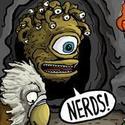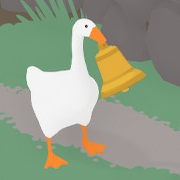|
Awesome! Thanks Asymmetrikon and Meinberg, 'tis much appreciated. In case anyone is wondering, this is for my 4e hack/heartbreaker (using 1d6 for one-handed weapon damage, 2d6 for two-handed) quote:Normal Attack: roll the attack dice (1d6 and 1d10)
|
|
|
|

|
| # ? Jun 8, 2024 22:49 |
|
P.d0t posted:Awesome! Thanks Asymmetrikon and Meinberg, 'tis much appreciated. Some oddities I see:
|
|
|
|
eth0.n posted:Some oddities I see: Yeah, the basic idea is that Lethal Strike fills the "design space" of a typical Critical Hit, whereas a Critical Hit in this game is more akin to a 4e "high crit weapon." Had I left it where rolling max die value on your attack did nothing special, it would seem sorta odd, so I tacked Crits onto that. Crits are meant to be rare, but a "nice to have" bonus to a normal hit when they do happen. Missing is bad because you probably get Counterattacked/Counterspelled. DR ranges from 3-7 in lowest tier and 7-10 in highest tier. Your at-will damage expression is going to be something like [1 or 2]d6+[6 or 7], and then you tack Encounter power damage onto that (only on a hit, btw), similar to Power Strike from essentials. Which you get more of (and bigger) as you level; if anything I've been told the DR becomes irrelevant at higher levels.
|
|
|
|
P.d0t posted:Your at-will damage expression is going to be something like [1 or 2]d6+[6 or 7], and then you tack Encounter power damage onto that (only on a hit, btw), similar to Power Strike from essentials. Which you get more of (and bigger) as you level; if anything I've been told the DR becomes irrelevant at higher levels. Ah, OK. Missed the Damage Modifier. A table that summarizes all the different things different attributes add to would be nice. Like the Armaments table.
|
|
|
|
eth0.n posted:Ah, OK. Missed the Damage Modifier. A table that summarizes all the different things different attributes add to would be nice. Like the Armaments table. No worries. Yeah I'm constantly making minor edits, so lately I've been considering adding the class-based damage mod to the attribute section. Basically there's a lot of different things that could be mentioned in multiple areas, but I tried not to be too repetitive; far too many people were bemoaning how long the doc was. e: Put in an appendix with a table P.d0t fucked around with this message at 21:14 on May 14, 2014 |
|
|
|
When using 3D6 in a roll under situation, is there a noticable difference between "roll four, drop the lowest" and "reroll 6s" ?
|
|
|
TheSpookyDanger posted:When using 3D6 in a roll under situation, is there a noticable difference between "roll four, drop the lowest" and "reroll 6s" ?
|
|
|
|
|
Assuming I'm not being an idiot and "3d6, reroll 6s" is equivalent to "3d5" (right???), here are some probability tables. I'm comparing 3d6 reroll 6s and 4d6 drop highest, and then 3d6 reroll 1s (which I'm interpreting as 3d5+3) and 4d6 drop lowest. There's a fairly noticeable difference, as the 4d6 drop methods both allow the full range of 3-18 while having the peak further towards the way it's nudged with that method (that is, for reroll 6s vs drop highest, the peak is at 9 for reroll and 8 for drop). e: If it matters, compared to 3d6, the drop method seems to more closely preserve the height of the curve/the probability of the average result, compared to the reroll method which scrunches up the curve. zachol fucked around with this message at 03:40 on Jun 18, 2014 |
|
|
|
Zereth posted:Well, rerolling sixes would lower the average, while 4d6 drop lowest would raise it. I meant drop the highest, but i'm pretty dumb  zachol posted:Assuming I'm not being an idiot and "3d6, reroll 6s" is equivalent to "3d5" (right???), here are some probability tables. Awesome, thank you. I was having a lot of trouble figuring out how to model that in anydice.
|
|
|
|
On a practical level, one requires pattern recognition plus an additional manual dexterity moment to solve your moment of tension versus a double-layered pattern recognition. 4d6 drop the highest is faster, I would think.
|
|
|
|
TheSpookyDanger posted:Awesome, thank you. I was having a lot of trouble figuring out how to model that in anydice. So did I. You wouldn't believe how long I spent trying to figure out how to get the thing to do rerolls before giving up and saying "3d5." Would it kill the guy to give a little bit more explanation of how the functions work or like some practical examples or something. I still don't understand how I'd handle, say, rerolling 4s or something. Also, I think the "additional manual dexterity movement" is the big thing. Rerolling 6s introduces that extra step of movement, which could be irritating depending on rolling habits/location.
|
|
|
|
You can construct arbitrary dice using "d{whatever}". So as long as you always reroll 4s, it could be like "d{1, 2, 3, 5, 6}" since a 4 never comes up. If its a one time reroll then I don't know.
|
|
|
|
|
zachol posted:
Also, something I've noticed at my table, is that some players will hate it when things aren't going their way. It adds another step to their "misery" (I have a very bitter friend).
|
|
|
|
PublicOpinion posted:You can construct arbitrary dice using "d{whatever}". So as long as you always reroll 4s, it could be like "d{1, 2, 3, 5, 6}" since a 4 never comes up. If its a one time reroll then I don't know. Oh! Ha, duh. Thanks. I'm fairly sure I understand how to do if statements which could handle one-time rerolls. There probably isn't a generalized indefinite reroll function because doing it the way you just said is the actual right way to do it without introducing extraneous steps.
|
|
|
|
AlphaDog posted:I posted a while ago somewhere that I was thinking of writing a "Nelson's Royal Navy, but with airships" game, and I've been steadily working on the setting, and kind of on the rules too. Rules are probably going to end up being a *world hack because my original idea of using Crown & Anchor dice ended up looking pretty similar to DW. This is a pretty cool setting, but I'm concerned about possible player roles. If one of the PCs is the captain, the other PCs basically have to do whatever he says. (Assuming a ship run with British naval discipline, anyway.) If the captain is a NPC, then the players may get annoyed at being at the whim of your NPC. Not a showstopper by any means, but something to think about.
|
|
|
|
inklesspen posted:This is a pretty cool setting, but I'm concerned about possible player roles. If one of the PCs is the captain, the other PCs basically have to do whatever he says. (Assuming a ship run with British naval discipline, anyway.) If the captain is a NPC, then the players may get annoyed at being at the whim of your NPC. Not a showstopper by any means, but something to think about. Another possibility: have the captain be a "group" character; i.e., everyone gets input on what he does and what decisions he makes. Have a mechanism to resolve disputes between players, either majority rule, or require that everyone come to a unanimous consensus of some sort. Generally, the focus of the action would be on the members of the crew that each player plays individually, but the captain would be there where needed by the story. I played in a campaign for a while that was sort of Shadowrun-ish, where we ran the owner of the corporation our primary characters worked for as a group character. It worked pretty well. eth0.n fucked around with this message at 15:36 on Jul 7, 2014 |
|
|
|
I'm still working on it - just focussed on other things for the last month or two. I can't believe I didn't explain the captain thing! Or maybe I hadn't thought it through when I posted. Anyway, it's something that I did put some thought in to. The "group character" (GC) captain is something I'd thought of, but it comes with its own host of problems, both systemically (I've never played a game with group characters) and thematically (what happens when a GC captain inevitably dies and all his trusted lieutenants are PCs?) My solution was this: Nobody is captain. Yes, that's somewhat counter to the source material (such as it is), but I decided that it's a necessary deviation. The PC's are the ship's masters. One is the Sailing Master, one is the Gunnery Master, one is the Master of Marines, one is the Science Master, one is the Master Navigator, etc. Different ships will have different sets of masters depending on role, size, etc (ie, depending on what players want to play as). If your character dies, they get replaced by the next in line (the Master's Mate) who is already described as a companion-NPC and - importantly for the fiction - already halfway around the world with the rest of the PCs. Your new character has to promote a new Master's Mate (ie, create a new companion character) from the crew. It's almost impossible for a player to be without a character barring the loss of the ship with most hands - which is pretty much a game-ending disaster anyway. Actions are decided on by committee because Elector_Nerdlingen fucked around with this message at 11:14 on Jul 28, 2014 |
|
|
|
A few different topics I'd like to discuss related to competitive strategy games. --- Random elements vs no random elements in a competitive strategy game. As a player and game designer, I vastly prefer no random elements. It helps put the emphasis on the strategy portion and allows players to plan out more than a turn ahead. On the other hand, it denies emergent gameplay, and removes any ability for "woah, did that just happen?!" moments. Thoughts? --- How complicated is too complicated for a competitive strategy game? How much can players and/or a GM be expected to keep track of while keeping it fun? More complicated mechanics allow for interesting emergent strategy. Unfortunately it also widens the gap between experienced and new players, and can turn off players before they begin. Simpler mechanics allow for more social-based gameplay, which is definitely a plus, but may deny certain ideas from being explored in a mechanical sense. It goes without saying that, regardless of how complicated the mechanics are (or not), they should be expressed in the simplest way possible. For example, in a game I'm working on, time travel is a mechanic. Unsurprisingly it is also the most complicated one. Opinions? --- Diplomacy (the game) style diplomacy in a strategy game. How fun/unfun does it inclusion make a game, and what sort of mechanics do you think facilitate it? --- Asymmetric play in a strategy game, where the players have access to different abilities, and maybe even different (yet competing) goals. Ya or nay, and why? --- In my opinion there are two types a strategy games; pick up and go games where everything in laid out for the players already, and 'design' games where players must put together something unique before they can play. Think the difference between chess (pick up and go) and a grognard variant of chess where your pieces at the start aren't set in stone and you buy them with points, ending up with something crazy like 3 queens, 3 bishops, and a pawn vs 12 pawns, 6 knights, and 2 rooks. Which sort of game do you think is more fun, and why? Pros and cons?
|
|
|
|
I prefer games that are low on random elements but not devoid of them. Randomization helps keep play fresh from game to game and allows for a little more risk-taking, but too much randomness just leads to Risk where the strategy is just "have more dice". I personally like complicated games, but they're way, way harder to find other players for. It's a lot easier to get a group together to play Settlers of Cataan than Race for the Galaxy or (heaven forbid) Twilight Imperium, even if the subject matter isn't a factor. Asymmetric play goes right up there with complexity, and so does pick-up-and-play vs design-your-own. There are ways to do it right (Small World manages a good mix of the two IMO) but it's a lot harder than it looks.
|
|
|
|
Zurai posted:I prefer games that are low on random elements but not devoid of them. Randomization helps keep play fresh from game to game and allows for a little more risk-taking, In addition to that, I like some randomization because it takes off the pressure of having to plan out the entire game in your head. If you have the kind of randomization where you can have a good grasp of the situation and optimise your tactics for, say, only three turns ahead before it turns too uncertain, then it would hit the sweet spot for me.
|
|
|
|
Also, reading this thread makes me need to ask this question: What, exactly, is a "hack" and under what terms is it legal to sell one (or, in general, third party content to an existing title).
|
|
|
|
Jon Joe posted:Also, reading this thread makes me need to ask this question: What, exactly, is a "hack" and under what terms is it legal to sell one (or, in general, third party content to an existing title). Not a lawyer, but as far as I know, the only time it's legal to sell third party content for an existing rules system is if you have a license agreement which says you can. For D&D 3.0 and its various follow-ups, that's the OGL (Open Game License). A hack is when you alter the rules of an existing system. It's basically just another name for house rules, although usually house rules don't go as far as some hacks do.
|
|
|
|
Not a lawyer, but considering that game mechanics aren't copyrightable (and very few are patented), as long as you avoid trademarks and reuse of expression of game mechanics (which is copyrightable), I don't think OGL or similar license is necessary for third party content. OGL is kind of useless for any purpose other than letting people post your rules in online SRDs, and produce whole competing games. Which is probably not what WotC had in mind. It's not needed to allow third party content, and the "share-alike" provisions it has are pointless, thanks to Product Identity. However, most people on SA talking about "hacks" are talking about Dungeon World hacks, which is under creative commons license. So you can do pretty much whatever you want as long as you provide attribution.
|
|
|
|
eth0.n posted:Not a lawyer, but considering that game mechanics aren't copyrightable (and very few are patented), as long as you avoid trademarks and reuse of expression of game mechanics (which is copyrightable), I don't think OGL or similar license is necessary for third party content. It is if you want to market or advertise your product as "compatible with D&D!" or whatever. It's a lot harder to sell a third party product when you can't say what your product is for and you have to re-write the rules in everything you make using your own language, no copy/pasting allowed. So yeah, it's not strictly necessary, but in practical terms it is.
|
|
|
|
So if I use OGL on a third party product, I can sell it and use terms/names from the original product?
|
|
|
|
For the OGL specifically, you can refer to any rules text covered by the OGL, including things like class and (most) spell names, but you cannot use any intellectual property, which is basically any of the deities or character names as well as a few of the monsters. Basically, Wizard is perfectly fine (and would be without OGL) but Mordenkainen (or Mordenkainen's disjunction) is not.
|
|
|
|
Alright, that's interesting. Now for a few other questions; How would developing a setting for an existing system work? How would developing a new subarea or character for an existing setting work? How would developing a new system for an existing setting work? Are those all covered OGL? Also: How can I check if an existing product uses OGL? Where would that information be located? Or is it just assumed that most big game companies use OGL on their product? If I create a completely original product, should I use OGL?
|
|
|
|
Zurai posted:It is if you want to market or advertise your product as "compatible with D&D!" or whatever. It's a lot harder to sell a third party product when you can't say what your product is for and you have to re-write the rules in everything you make using your own language, no copy/pasting allowed. OGL doesn't allow "Compatible with D&D". It actually specifically prohibits it. Ordinarily, you can say that your product is compatible with another, but not if you use OGL. WotC used to offer a separate license for compatibility claims, but that's no longer available. The rewriting rules bit might be important, but it depends on the product. If it's a supplement or adventure, how many rules are you really rewriting? Jon Joe posted:Alright, that's interesting. Now for a few other questions; Yes, for the first. You wouldn't need the OGL, though. For the other two, depends on the specifics. Setting details are often Product Identity, and thus not covered by OGL. quote:How can I check if an existing product uses OGL? Where would that information be located? Or is it just assumed that most big game companies use OGL on their product? The OGL needs to be included in a published work for it to apply. You should not assume that most companies use it. It's WotC's baby, and only DnD offshoots use it, mostly. I would not license a new product under OGL. I'd use some breed of creative commons (Share Alike, possible Non-Commercial). eth0.n fucked around with this message at 17:30 on Aug 5, 2014 |
|
|
|
Jon Joe posted:How would developing a setting for an existing system work? This you could do without OGL. In fact, the best settings (IMO) are the ones that are completely system-neutral. quote:How would developing a new subarea or character for an existing setting work? Settings are intellectual property. That way lies legions of corporate lawyers. quote:How can I check if an existing product uses OGL? Where would that information be located? Or is it just assumed that most big game companies use OGL on their product? OGL is specifically the license released to allow third-party publishers to publish products for the 3.0/d20 system. Literally any third party product released for 3.0, 3.5, Pathfinder (including the Pathfinder core rules themselves), or any other d20 System game uses OGL. The terms of the OGL requires there to be notice inside the book (small print on the credits page usually). If your product is completely original, you don't need OGL, because again that is a specific license rather than a general term. Whether you should or should not use an open license is up to you. eth0.n posted:OGL doesn't allow "Compatible with D&D". It actually specifically prohibits it. Ordinarily, you can say that your product is compatible with another, but not if you use OGL. WotC used to offer a separate license for compatibility claims, but that's no longer available. Sorry, yes, I was speaking in general terms that you need a license to claim compatibility, not specifically the OGL. It's the same with Paizo; you can release rules for Pathfinder under the OGL, but there are additional steps if you want to be able to actually state it's Pathfinder Compatible. quote:The rewriting rules bit might be important, but it depends on the product. If it's a supplement or adventure, how many rules are you really rewriting? Well, you couldn't use shortened statblocks (because you couldn't refer to your source products), which would make adventures hell. You couldn't even use their statblock format if I understand things correctly. It's doable, but a lot of hassle and wasted space.
|
|
|
|
What sort of licence do non d20 products use, then? For example, World of Darkness?Zurai posted:This you could do without OGL. In fact, the best settings (IMO) are the ones that are completely system-neutral. Do people even make/sell no-system settings through places like DriveThruRPG?
|
|
|
|
Zurai posted:Sorry, yes, I was speaking in general terms that you need a license to claim compatibility, not specifically the OGL. It's the same with Paizo; you can release rules for Pathfinder under the OGL, but there are additional steps if you want to be able to actually state it's Pathfinder Compatible. That's because Pathfinder is OGL. My understanding is that by default, you don't need anything to say your thing is compatible with another thing. OGL actually makes you give up that right. quote:Well, you couldn't use shortened statblocks (because you couldn't refer to your source products), which would make adventures hell. You couldn't even use their statblock format if I understand things correctly. It's doable, but a lot of hassle and wasted space. I don't think you can't refer to source products. Just can't duplicate their content. Shortened statblocks are the devil anyway. Include full stats for everything, and you won't need worry about that. Jon Joe posted:What sort of licence do non d20 products use, then? For example, World of Darkness? Don't know about WoD specifically, but most non-indie RPGs are just plain "All Rights Reserved". Like any other books. quote:Do people even make/sell no-system settings through places like DriveThruRPG? Sure. A guy here even sells various lists of a hundred things. No mechanics, just lists of ideas. eth0.n fucked around with this message at 17:43 on Aug 5, 2014 |
|
|
|
Jon Joe posted:Do people even make/sell no-system settings through places like DriveThruRPG? Yep! One example: the recently-released Guide to Glorantha is 800 pages of campaign setting with zero rules text anywhere. It's completely system-neutral, even though Glorantha is the default setting for the RuneQuest and HeroQuest RPGs. eth0.n posted:Shortened statblocks are the devil anyway. Include full stats for everything, and you won't need worry about that. Says someone who's never had to think about word or page count. Do you realize how many words are in even a fairly weak and generic Pathfinder monster statblock and how much space it takes up on the page? Should I also include full text for every spell that 20th level archmage has memorized? Zurai fucked around with this message at 17:43 on Aug 5, 2014 |
|
|
|
Zurai posted:Says someone who's never had to think about word or page count. Do you realize how many words are in even a fairly weak and generic Pathfinder monster statblock and how much space it takes up on the page? Should I also include full text for every spell that 20th level archmage has memorized? If you're making specifically 3E/3.5/PF content, then yeah, you should probably just use the OGL. All that bullshit cross-referencing stuff is par for the course in that world. My point is more that a game not being OGL doesn't mean you can't do supplemental stuff for it. For a game that isn't insanely bloated, incomplete statblocks are bad.
|
|
|
|
Oh, a few questions relating to sale-ability! Is there a market for systems without (or minimal) setting/fluff? I make a lot of competitive (2+ players) strategy games, many of which I have finished, but are without art/story. As I understand it grognards are hard to sell on artless products, but I figure I'd ask anyway. Where on DriveThruRPG can I change back to non-exclusive sale? When I made my account I set it for exclusive sale because I wanted to make more money. Since that time I've still yet to release a product, and have changed my mind to wanting to sell non-exclusively so I can host the product myself in the future after I've made enough money to do so. Anyone have any advice on marketing once my games are released? I realize I can advertise them here, and should probably also make a facebook/twitter account for my game company, but I'm not quite sure beyond that.
|
|
|
|
Jon Joe posted:Random elements vs no random elements in a competitive strategy game. I don't think that's really the case. Take a game like Starcraft. Even after Blizzard stopped patching more than once every couple years, people kept developing new strategies and build orders, targeting existing builds and strategies; a kind of natural selection/evolution of strategies considered most effective at any given time, which varied as the they responded to each other reflexively ('metagame'). That's almost entirely emergent. And SC1 has very little randomness--player spawning positions around the board at the start of each game are randomized, and ranged units very rarely (5%?) miss targets usually, or 70% of the time when their target is behind a tree/up a cliff; SC2 has even less randomness, with none of those chances to miss. But because there's such a massive action space of what to do and where to do it at any given second, and players have limited information, there's a lot of opportunity for surprise.
|
|
|
|
Competitive players will always prefer to minimize randomness in a game. It assures that the more skilled player will win. The problem is that games without random factors, such as Chess or Go are only compelling when the players are of nearly equal skill. This is why games without randomness tend to have small dedicated competitive players and very few casual fans. Highly random games appeal to less skilled players, it allows someone to get lucky and win. Games like Roulette or Yahtzee have high randomness and can be fun for players of vastly different skill levels. If a game has too much randomness, then competitive play becomes pointless as winning is more about luck than skill. The best games, the ones that are most successful manage to balance the two factors, games like Texas Hold'em, Scrabble, or Magic allow a lot of skilled play making the better player more likely to succeed, but random chance still gives an unskilled or new player a chance to pull out a win once in awhile which keeps them engaged. If you look at TCG games you can always tell which ones were designed by competitive magic players because the first thing they do is eliminate mana screw in some way. The thing is, mana screw is what has made Magic so successful because without it new players would have no chance against established players and would quickly leave the game. Since every once in awhile that new player gets a perfect draw against Mr Suitcase and pulls out a win that new player will stick around and become more invested in the game.
|
|
|
|
I'm used to DM'ing for AD&D2e so i'm used to processing needlessly complicated rules. There is nothing elegant about my rule set. But once you know it, it can be applied to anything, and it can be very detailed. There are optional rules on top of optional rules. This is to show how detailed the expanded process can be for an attack. I use a modified THAC0 system. So in AD&D2e there is a two tiered hit system, hit and miss. In my rule set there is a three tiered hit system; unarmoured hit, armored hit, and miss. When something hits helm the helm absorbs some portion of a blow’s damage, its damage threshold. It the damage doesn't exceed the DT then the attack is effectively a miss. The attack involves 3 sets of die; the die to hit, the die determining the location of contact, and the die (or series of die) which determine the damage inflicted. EX: A man with a THAC of 15 and a Bolt Action Rifle (1d6+5, 480m, 5/1, [10 shot]) attacks a man with an AC of 10 (Steel Mantel DT 28, Steel Helm DT 14). He declares that he will be making an aimed shot. First there is the roll to hit, and then there is a d20 roll which determines which body part is hit, a table will show the hit probabilities for the target, with the armor above and the extent that damage will be mitigated. If he makes contact he'll roll for damage. So that's one shot, there are different types of direct fire missile attacks. (There are also different types of Missile attacks) Aimed shot: If successful an aimed shot will make contact with a random part of the defenders body. If initially declared, it allows the attacker to unload a portion of his magazine with some precision. Failing this means a guaranteed miss. This will use up the attackers standard action and his minor action for the round. Precise Shot: A precise shot limits the attacker to one shot but lets him pick the point of impact, failing this attack will reduce the accuracy to a single aimed shot. This will use up the attackers standard action and his minor action for the round. Hip shot: Not necessarily from the hip and performed without effective use of sights. In a hip shot the player uses only his standard action; he receives a +10 modifier to his THAC for that attack. In all other ways it is similar to the aimed shot. If a weapon has no sights, then it can only be used in this role. I find if the player rolls all the die needed for an attack in one go, you can still have a pretty quick round. Scavanna fucked around with this message at 21:15 on Aug 11, 2014 |
|
|
|
An idea that recently came to me, I'm bouncing it around to see what is produced. It's for a martial arts system, possibly for Savage Worlds. Essentially each martial artist would have an arsenal of Moves. These aren't meant to represent specific actions or anything, that's just the best martial-artsy term I've thought up so far. They're more like approaches to combat. Anyway, you've got a certain selection of Moves based on whatever fighting style you practice. You also have a certain number of "slots" which are the Moves you can currently have active on any given turn. Think of it like cards, you've got a "hand" of Moves and you can put so many of them "in play" at once. For example, an aggressive, powerful combat style might grant you Moves like Power (boosts damage), Accuracy (boosts chance-to-hit), and Speed (increases movement). A novice character might have only one open "slot" to activate Moves so in one turn they can switch between any one of those three priorities: damage, accuracy, or movement. A higher level martial artist would earn more slots and thus can have multiple moves in play at once, or repeats of the same move to boost their effect. So a martial artist with 3 slots could have all 3 Moves active at once, double up one one and still have one more move, or go all-in on one move. In addition, as you improve you might get the chance to pick up additional Moves and advanced moves which would be more specific and powerful (and might require some sort of power points/etc to trigger). This would be things like energy blasts, multiple attacks, etc. Sounds a little overcomplicated on paper but I think it would be intuitive enough in play, and I think I like the combination of thematic fighting styles with turn-to-turn flexibility. Any thoughts? Am I accidentally copying some existing system?
|
|
|
|
oriongates posted:Any thoughts? Am I accidentally copying some existing system? It sounds similar to Fate's Aspects. If you haven't already, reading the rest of the system may give you ideas for integrating your core mechanic above into a larger rules system. http://www.faterpg.com/dl/df/aspects.html
|
|
|
|

|
| # ? Jun 8, 2024 22:49 |
|
I'm pretty down with FATE already, but I don't think they'll work out much like Aspects in-play. They're meant to have specific, rather than situational, effects and they aren't directly tied to a fate point style economy. The idea is meant to work a bit like Exalted's Charms, but removing or minimizing the essence economy. Rather than paying X essence to activate your [Charm that boosts damage] you simply have a card in play, and so long as it is in play you get a damage bonus. As you power up you can increase the effectiveness of one of your Moves by "doubling up" on them or combo several Moves together to produce a greater effect.
|
|
|































